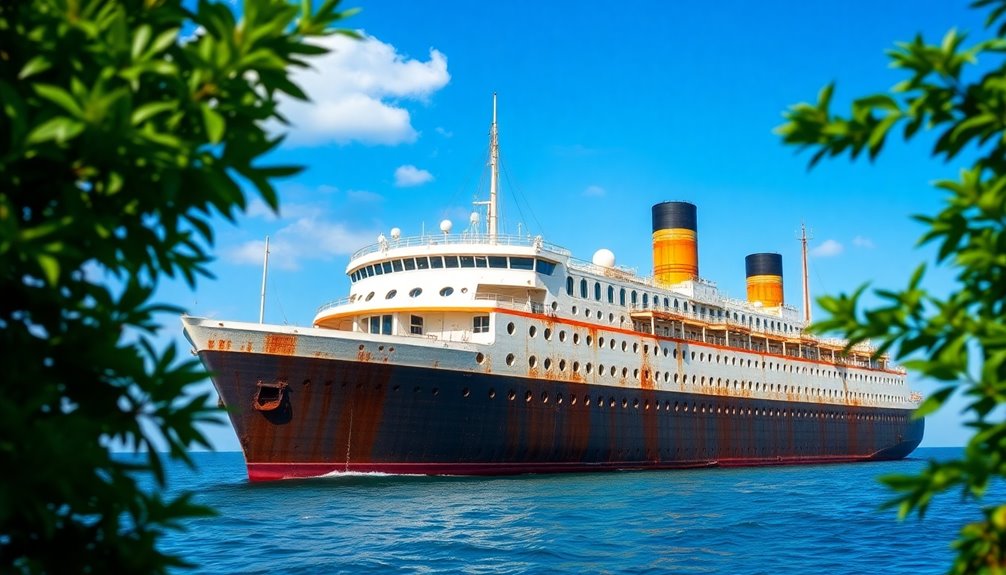When exploring the oldest cruise ship still in service, you'll find the remarkable Sea Cloud, built in 1931. Once a private yacht, it now offers a luxurious sailing experience, retaining 10 historic staterooms. It's not alone; ships like the MV Astoria, launched in 1948, also share fascinating histories. You can initiate adventures aboard the Nordstjernen, known for Arctic exploration. Each vessel showcases unique stories that connect you to maritime heritage. If you're keen to learn about more ships and their enchanting journeys, there's a lot more to uncover!
Key Takeaways
- The oldest cruise ship still in service is the Sea Cloud, built in 1931, originally a private yacht, showcasing rich maritime history.
- The MV Astoria, launched in 1948, transitioned from passenger liner to cruise ship, representing a significant link to maritime heritage.
- Historic ships like Nordstjernen and Hebridean Princess offer unique experiences and emphasize the blend of tradition and modern luxury in cruising.
- Vintage cruise ships often feature original staterooms and maintain historical significance, appealing to niche audiences seeking retro-themed cruises.
- The cruise industry is evolving with a focus on preserving classic ships while addressing modern safety and environmental standards.
Overview of Oldest Cruise Ships
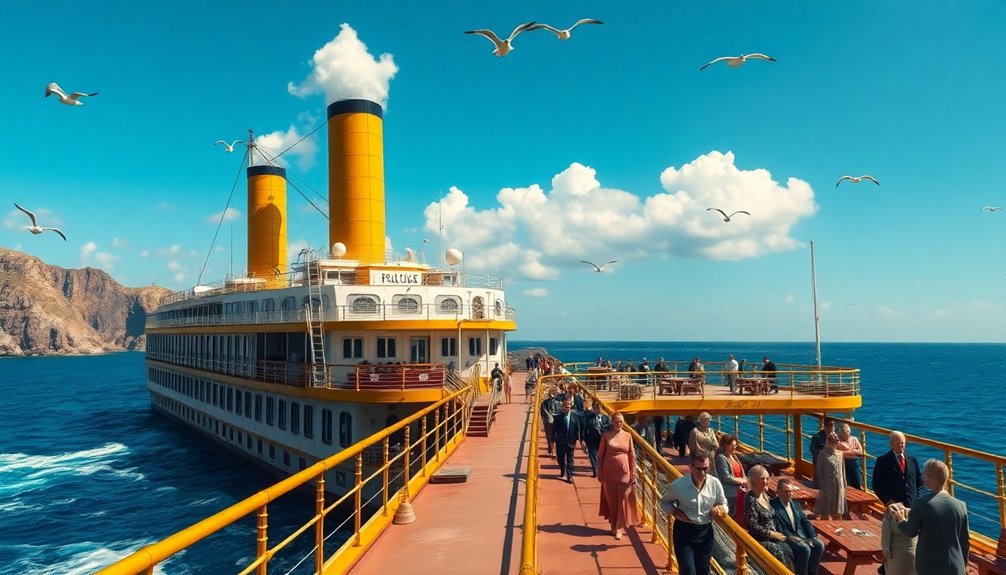
When you think of cruise ships, age mightn't be the first thing that comes to mind, but some of the oldest vessels still in service today have fascinating stories.
The Sea Cloud, for instance, is a stunning 92-year-old ship that began as a private yacht before transforming into a cruise vessel. Aging fleets represent a significant portion of the global cruise industry.
Then there's the Nordstjernen, a 67-year-old ship conducting summer programs in Svalbard.
Other notable vessels include the 61-year-old Callisto and Galapagos Legend, both offering unique cruising experiences.
The Hebridean Princess, at 59, sails through the picturesque Scottish Highlands, while the 62-year-old Funchal has undergone multiple refurbishments.
Each of these ships not only showcases maritime history but also proves that age can enhance a ship's charm and character.
The Sea Cloud: A Historical Gem

Among the remarkable ships still cruising today, the Sea Cloud stands out as a true historical gem. Built in 1931 in Germany and originally named Hussar V, it was the largest private sailing yacht at its time.
Designed by Marjorie Merriweather Post, the ship reflects her elegant style. During World War II, it served the U.S. government for just $1 a year. The Sea Cloud was also leased by the U.S. government during this period, showcasing its significance beyond luxury.
Since 1981, preservation-minded German owners have maintained its charm, keeping 10 historic staterooms and Marjorie's original possessions on board. The Sea Cloud features modern amenities like a Lido Bar and a musician lounge while retaining its classic allure.
As a four-masted barque, it continues to enchant 64 passengers with its rich history and elegance.
Nordstjernen: Arctic Adventures
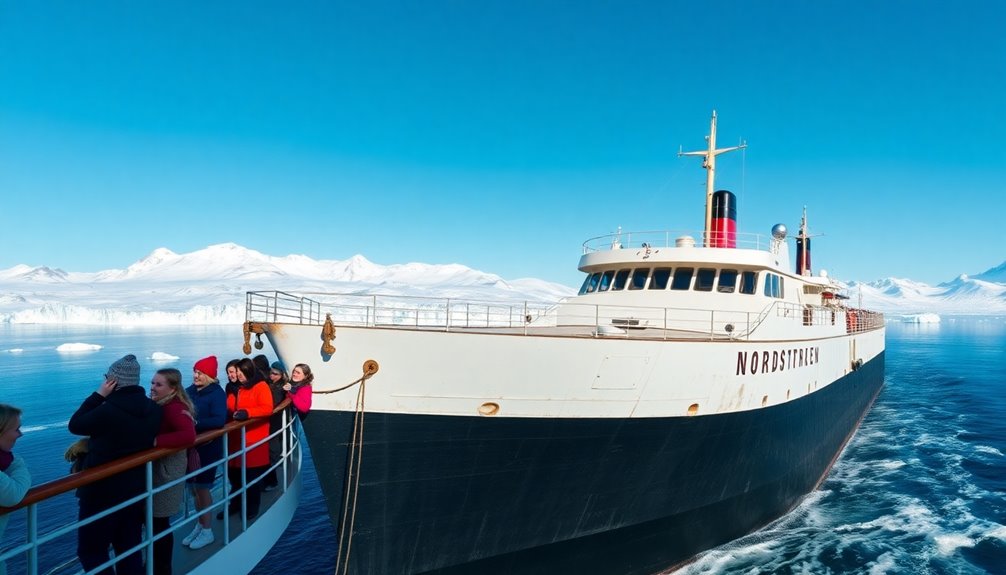
Nordstjernen, a stalwart of Arctic exploration, has long been a favorite among adventure seekers. Launched in 1955, she entered Hurtigruten service in 1956 and quickly gained popularity. Over the years, she introduced the Svalbard Express service and offered cruises to the Shetland Islands. After modernization in 1983, which boosted her speed and refined her interiors, she continued to thrive. Notably, she was built during the post-WWII recovery period, marking a significant era in maritime history.
Here's a quick overview of her remarkable journey:
| Year | Milestone | Notes |
|---|---|---|
| 1955 | Launched | Built at Blohm & Voss |
| 1968 | Svalbard Express introduced | Popular Arctic route |
| 1983 | Major modernization | New engine installed |
| 1994 | Svalbard cruises began | Successful summers |
| 2006 | Celebrated 50th birthday | Returned to Hamburg |
Callisto and Galapagos Legend
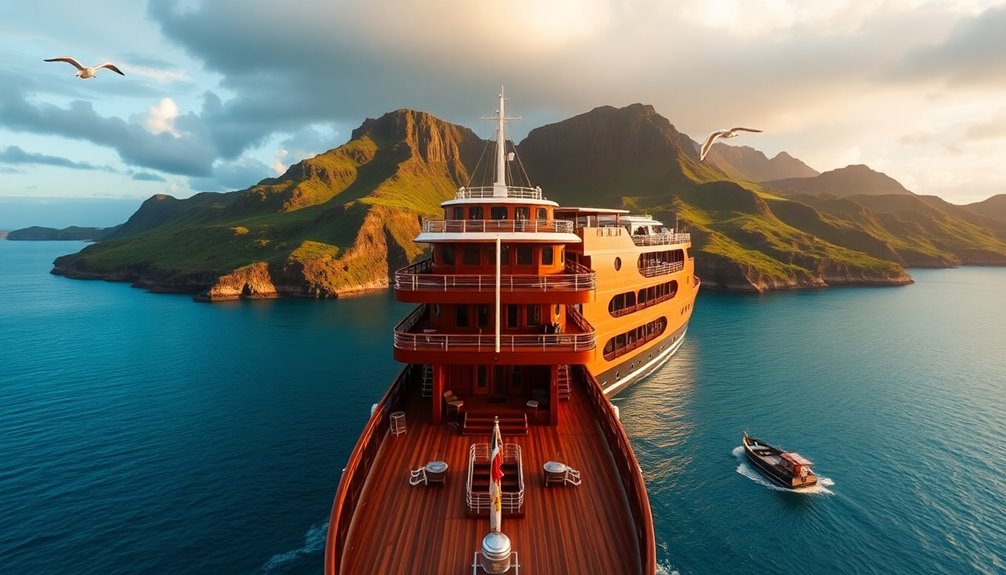
When you look at the Callisto and Galapagos Legend, you'll notice their unique specifications and the distinct cruising experiences they offer.
Both vessels have rich histories that contribute to their legacies in the world of maritime travel. The MS Callisto, a fully renovated motor-yacht, accommodates 34 passengers, providing a personalized service experience with a dedicated crew of 17 for luxurious comfort.
Explore how their itineraries and designs cater to different types of adventurers while highlighting their historical significance.
Vessel Specifications Overview
In the domain of cruise ships, the Callisto and Galapagos Legend stand out with their unique specifications tailored for different experiences. Here's a quick overview of their key features:
| Specification | Callisto | Galapagos Legend |
|---|---|---|
| Length | 164 feet (50 m) | 300 feet (91 m) |
| Capacity | 34 passengers | 100 passengers |
| Year Built | 2000 (Renovated 2015) | 1963 |
The Callisto offers a cozy atmosphere with 17 en-suite cabins, while the Galapagos Legend boasts extensive amenities, including a swimming pool and gym. Additionally, the Galapagos Legend is operated by an Ecuadorian company, enhancing the local experience for its passengers. Both vessels guarantee safety and comfort, making them excellent choices for your next maritime adventure.
Cruising Destinations Offered
Both the Callisto and Galapagos Legend offer diverse cruising destinations that cater to different interests and adventures.
Whether you're drawn to the enchanting Mediterranean or the unique ecosystems of the Galapagos, both vessels promise unforgettable experiences.
- Callisto: Explore the Greek Isles, Dalmatian Coast, and Adriatic wonders.
- Costa Rica and Panama: Enjoy coastal explorations and Atlantic crossings.
- Galapagos Islands: Discover iconic sites like Darwin Bay and Black Turtle Cove.
- Island Hopping: Engage in snorkeling, kayaking, and wildlife encounters on various islands.
- Cultural Experiences: Visit interpretation centers and engage in educational activities. The Callisto, a motor yacht, is known for its boutique cruising style and high standards of accommodation. This approach to travel aligns with the principles of positive thinking, enhancing your overall experience and enjoyment.
With these enthralling itineraries, you'll find the perfect adventure that suits your preferences and curiosity.
Historical Significance and Legacy**
Exploring the vibrant waters of the Mediterranean or the unique Galapagos Islands not only offers stunning landscapes and adventures but also connects you to the rich histories of the vessels that provide these experiences. The Callisto and Galapagos Legend showcase remarkable legacies.
| Ship Name | Historical Significance |
|---|---|
| Callisto | Coastal cruising in the Eastern Mediterranean. |
| Galapagos Legend | Hospital ship (1966-1971) with over 21,000 treatments. |
| Astoria | World's longest-serving cruise ship, nearly 75 years. |
| Galapagos Legend | Promotes conservation through educational activities. |
These ships not only traverse beautiful waters but also harbor stories of resilience, transformation, and cultural impact, enriching your journey with their historical significance. The Astoria, which served as a symbol of maritime evolution, reflects significant historical events, including its role during the Cold War. Additionally, the importance of understanding tax implications of Gold IRAs can offer a financial advantage for future maritime adventures.
The Hebridean Princess Experience
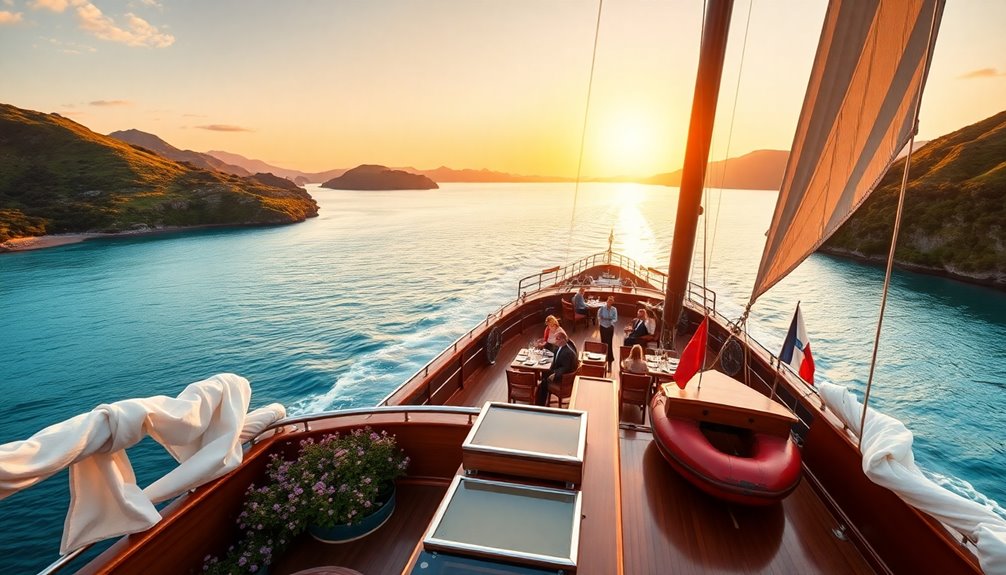
While sailing aboard the Hebridean Princess, you'll discover a unique blend of luxury and intimacy that sets this historic ship apart from larger vessels.
With a passenger capacity of just 48, you'll enjoy personalized service from the 38-member crew, ensuring every need is met.
- Experience the comfort of 28 individually designed cabins, complete with Molton Brown amenities.
- Savor all-inclusive meals and drinks during your journey through stunning destinations like Scotland and the Isle of Man.
- Engage with expert guest speakers on topics like horticulture and archaeology.
- Relax with daily mini-bar replenishment at no charge.
- Appreciate the traditional decor and unique access to remote areas, including Scotland's Western Isles.
Each moment on the Hebridean Princess is crafted for an unforgettable experience.
MV Astoria's Remarkable Journey
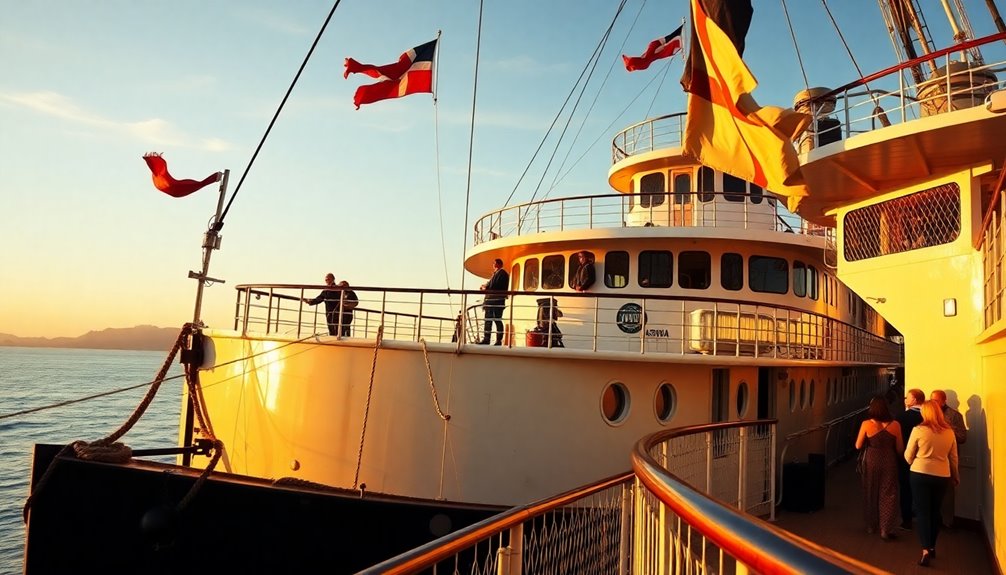
After exploring the intimate luxury of the Hebridean Princess, you'll find the MV Astoria offers a different yet equally fascinating cruising experience. Launched in 1948 as the Stockholm, this ship has seen it all—from tragic collisions to pirate encounters. Her journey reflects resilience and transformation. Notably, Astoria's arrival in Poole in 2018 marked a significant event for the region, showcasing Poole's port facilities to cruise passengers.
| Year | Event |
|---|---|
| 1948 | Launched as Stockholm |
| 1956 | Collision with Andrea Doria |
| 1993 | Rebuilt as a cruise ship |
| 2016 | Renamed to MV Astoria |
| 2020 | Continued operations until 2023 |
Now sailing under Cruise & Maritime Voyages, MV Astoria stands as the oldest deep-water passenger liner, a reflection of maritime history and adventure.
Expedition Fleet Highlights
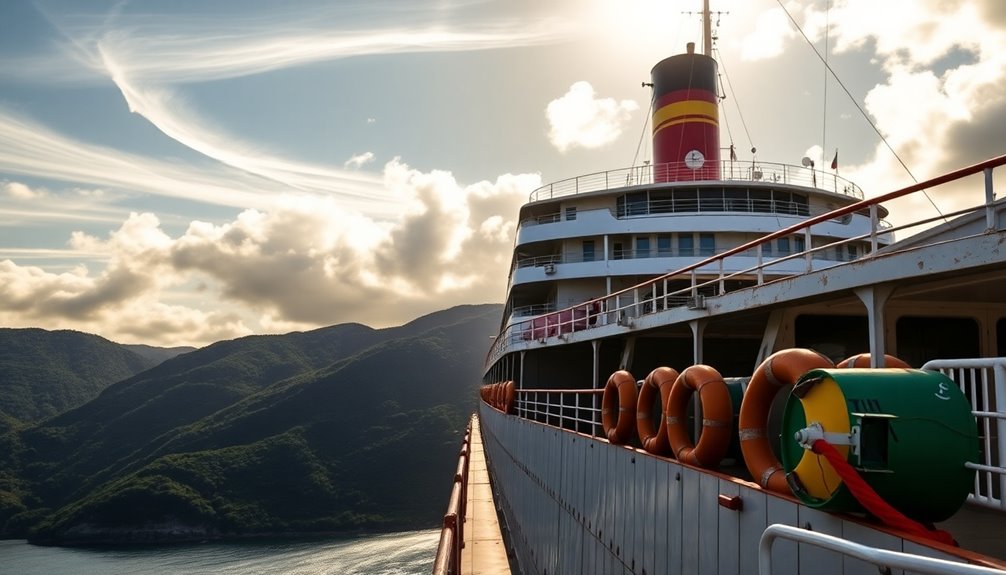
Expedition fleets offer a unique blend of adventure and accessibility, allowing you to explore remote destinations that larger ships simply can't reach.
With their smaller size and agility, these vessels navigate icy waters and hidden coves with ease, providing unforgettable experiences.
Here are some highlights:
- Access to Remote Areas: Smaller ships reach untouched locations.
- Ice-Strengthened Hulls: Designed to withstand harsh polar conditions.
- Observation Decks: Ideal for wildlife viewing and photography.
- Comfortable Facilities: Modern amenities for a pleasant journey.
- Expert Crews: Experienced professionals guarantee safety and success.
- Smaller Vessels are better suited for navigating icy waters, which enhances the overall adventure experience.
Evolution of Cruise Lines

As cruise lines evolved over the years, they transformed from simple passenger services into the luxurious floating resorts we recognize today.
You can trace this journey back to P&O Cruises, the oldest cruise line, which began its first passenger voyages in 1844. The market expanded considerably in the late 19th century, with advancements like diesel engines enhancing comfort. The introduction of passenger cruises in the mid-19th century marked a significant turning point in the industry. Additionally, cruise ship speeds have increased over the decades, allowing for more efficient travel between destinations.
By the mid-20th century, lines such as Norwegian Cruise Line and Royal Caribbean emerged, offering flexibility and luxury.
Today, modern lines like Celebrity Cruises and Disney Cruises cater to diverse preferences, providing unique itineraries and onboard experiences.
With mergers and technological innovations, the cruise industry continues to redefine travel, ensuring every journey is memorable and enriching.
Maritime Disasters and Their Impact
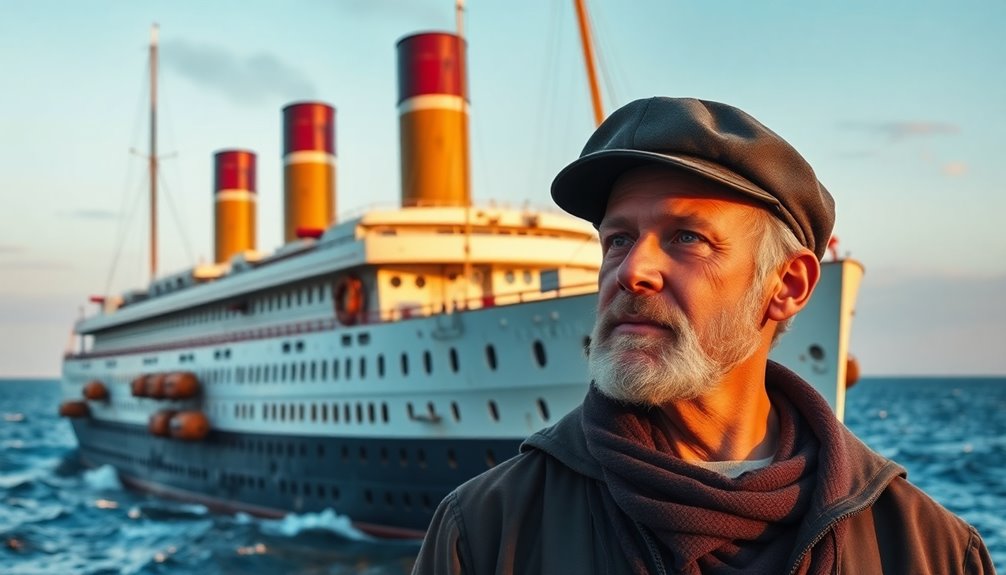
While maritime travel offers incredible experiences, it's not without its risks. Disasters can occur, affecting both passengers and the environment. Understanding these risks helps you appreciate the safety measures in place.
- Collision: Significant damage and potential loss of life can arise.
- Grounding: Running aground can lead to severe environmental pollution.
- Fire: Onboard fires can be catastrophic, threatening lives and vessels.
- Pollution: Oil spills pose severe environmental challenges.
- Human Error: Mistakes by crew members often result in serious incidents.
From 2014 to 2022, over 23,000 marine casualties were reported, highlighting the importance of vigilance and preparedness in maritime travel. In 2023, the total marine casualties reported increased by 10% compared to 2022, underscoring the ongoing need for safety measures.
Being aware of these risks enhances your appreciation for the safety protocols that protect you on your journey.
The Future of Vintage Ships
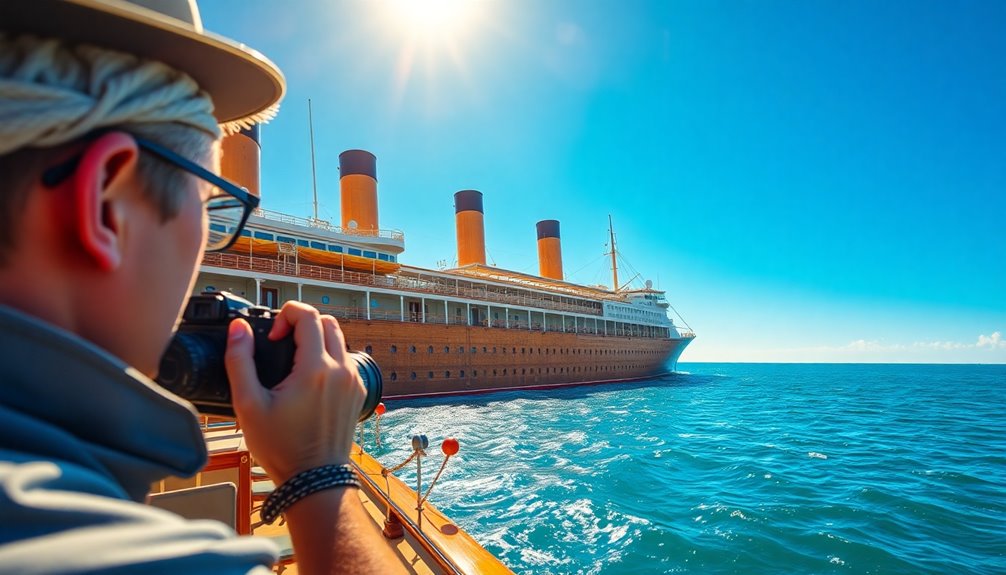
As you think about vintage ships, consider the balance between preserving their charm and meeting modern passenger preferences.
While some operators endeavor to maintain historical elements, others face challenges in adapting to new demands. The future of these vessels relies on innovative solutions that respect their legacy while appealing to today's travelers. However, the recent scrapping of vintage ships due to economic pressures highlights the urgency for these solutions.
Preservation Efforts and Challenges
Although vintage ships offer a unique charm and historical significance, preserving them presents considerable challenges.
You'll find that maintaining these vessels requires maneuvering through strict regulations, financial constraints, and environmental concerns. The process can be intimidating, but efforts are being made to guarantee these ships endure.
Here are some key factors to reflect on:
- Regulatory Compliance: Ships must meet modern safety and emission standards.
- Financial Burden: Upgrading older vessels can strain budgets considerably. Renovated ships can meet modern emission standards efficiently, making them a viable option for preservation.
- Environmental Risks: Scrapping processes can release toxic substances, especially in places like Alang, India.
- Technological Integration: New technologies need to be adapted for older ships.
- Market Demand: Growing interest in sustainable travel can support preservation efforts.
These aspects highlight the complexity of preserving maritime history.
Evolving Passenger Preferences
The landscape of cruise travel is shifting, influenced by evolving passenger preferences that reflect broader societal changes.
Older cruisers often gravitate toward vintage ships, appreciating their intimate size and charm, while younger families lean toward modern vessels packed with amenities. You'll notice that newer ships boast more balcony staterooms, diverse dining options, and advanced technologies, catering to a wider range of passengers. In fact, larger ships often provide extensive outdoor diversions, including water parks and roller coasters, which appeal to families seeking adventure.
Luxury lines continue to attract older travelers seeking relaxation, while innovative cruise lines entice tech-savvy younger crowds. Interiors blend classic styles with contemporary design, creating a perfect balance. As onboard experiences evolve, you can expect a mix of traditional charm and modern twists, ensuring that both vintage and modern ships coexist in the cruising world.
Frequently Asked Questions
What Amenities Are Available on Older Cruise Ships Like Sea Cloud?
On older cruise ships like Sea Cloud, you'll find a range of amenities designed for your comfort.
Each cabin features a large wardrobe, electronic safe box, and a cozy dressing table. Bathrooms are luxurious with marble tops and gold-plated fixtures.
You can relax at the Lido Bar or in the library, and enjoy fine dining with local cuisine and excellent wines.
Fitness facilities and spa treatments add to your experience, ensuring you’ll have a memorable trip. Whether you’re looking to unwind after a long day of sightseeing or seeking an invigorating workout, these amenities cater to every need. With a variety of classes and specialized treatments available, you have the opportunity to structure a meaningful retreat experience that rejuvenates both body and mind. Additionally, the serene atmosphere of the spa enhances relaxation, making it an ideal environment to recharge and reflect on your journey.
How Do Vintage Ships Compare to Modern Cruise Ships in Comfort?
When you compare vintage ships to modern cruise ships in comfort, you'll notice some distinct differences.
Vintage ships often feel more intimate with fewer passengers and wider corridors, making navigation simpler. They might lack advanced amenities like smart TVs, but their classic decor has a unique charm.
While modern ships offer elaborate entertainment and diverse dining options, vintage vessels provide a cozy atmosphere that many find appealing, blending nostalgia with comfort.
Are There Themed Cruises Available on Older Vessels?
You'll be thrilled to know there are themed cruises available on older vessels!
Imagine stepping aboard a ship filled with the vibes of the 90s, complete with live concerts and exciting parties.
Or picture yourself on a Star Trek-themed journey, where you can interact with beloved characters.
These cruises offer unique experiences, like music performances and themed events, all while exploring beautiful ports.
The adventure awaits—are you ready to set sail?
What Is the Environmental Impact of Operating Older Cruise Ships?
Operating older cruise ships has a significant environmental impact. They often emit as much air pollution as thousands of cars daily, harming air quality and human health.
Their wastewater discharges can disrupt marine ecosystems, releasing harmful chemicals and nutrients. Solid waste management is also a concern, with improper disposal contributing to ocean pollution.
While the industry is working towards greener practices, these older vessels still pose substantial challenges to marine environments.
How Can I Book a Cruise on the Oldest Ship in Service?
To book a cruise on the oldest ship in service, start by researching Sea Cloud Cruises, the operator of the Sea Cloud.
Check their website for itineraries that interest you, focusing on routes in the Caribbean and Mediterranean.
Compare prices and look for reviews from past guests.
Since older ships often have limited capacity, it's best to book early to secure your spot.
Enjoy your unique journey aboard this historical vessel!
Conclusion
As you sail into the future, it's crucial to remember the treasures of the past. Vintage cruise ships like The Sea Cloud and Nordstjernen not only offer unique experiences but also weave rich tapestries of maritime history. By embracing these timeless vessels, you're not just enjoying a vacation; you're becoming part of a story that spans decades. So, set your course for adventure and let the echoes of history guide your journey across the waves.
